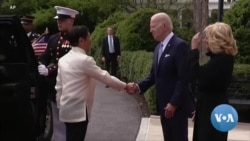ປະທານາທິບໍດີຂອງຟີລິບປິນ ທ່ານເຟີດີນານ ມາໂກສ ຈູເນ່ຍ ໄດ້ໄປຢ້ຽມທໍານຽບຂາວໃນວັນຈັນທີ່ຜ່ານມາ ເຊິ່ງເປັນຊ່ວງເວລາທີ່ມີຄວາມເຄັ່ງຕຶງ ຢູ່ໃນພູມິພາກອິນໂດ-ປາຊີຟິກ. ປະທານາທິບໍດີໂຈ ໄບເດັນ ກ່າວວ່າ ຄວາມມຸ່ງໝັ້ນຂອງສະຫະລັັດຕໍ່ປະເທດໝູ່ເກາະແຫ່ງນີ້ ແມ່ນ “ເຂັ້ມແຂງ” ທ່າມກາງການເສີມຂະຫຍາຍຄວາມຮ່ວມມືທາງທະຫານ, ທີ່ສົ່ງຜົນໃຫ້ຟີລິບປິນ ອະນຸຍາດໃຫ້ ສະຫະລັດນໍາໃຊ້ຖານທັບທາງທະຫານຢູ່ໃນປະເທດເພີ້ມອີກ 4 ແຫ່ງ. ອານິຕາ ພາວ ນັກຂ່າວຂອງ VOA ມີລາຍງານກ່ຽວກັບເລື້ອງນີ້, ເຊິ່ງ ທິບສຸດາ ມີລາຍລະອຽດມາສະເໜີທ່ານ ໃນອັນດັບຕໍ່ໄປ.
ການປະຊຸມ ແມ່ນໄດ້ລິເລີ້ມມາເປັນເວລາດົນກວ່ານຶ່ງທົດສະວັດ. ຄັ້ງຫຼ້າສຸດ ທີ່ປະທານາທິບໍດີຂອງຟີລິບປິນ ໄດ້ມາຢືນສະຫງ່າຢູ່ທໍານຽບຂາວ ແມ່ນປີ 2012.
ມີການປ່ຽນແປງຢ່າງຫຼວງຫຼາຍ ນັບຕັ້ງແຕ່ນັ້ນມາ, ແລະກໍບໍ່ແມ່ນແຕ່ຜູ້ນໍາຂອງປະເທດເທົ່ານັ້ນທີ່ປ່ຽນແປງ. ໃນວັນຈັນທີ່ຜ່ານມານີ້, ທ່ານ ໄບເດັນ ໄດ້ພິສູດໃຫ້ເຫັນເຖິງໄພຂົ່ມຂູ່ທີ່ຮຸນແຮງ, ທ່າອ່ຽງ ແລະໄດ້ລົງນາມ ໃນຂໍ້ຕົກລົງສະບັບ
ໃໝ່ສໍາລັບການຮ່ວມມືກັນ ທີ່ຈະເສີມສ້າງຄວາມເຂັ້ມແຂງໃຫ້ແກ່ຄວາມໝັ້ນຄົງຂອງປະເທດຟີລິບປິນ ແລະໃຫ້ການສະໜັບສະໜຸນການປັບປຸງກອງທັບໃຫ້ທັນສະໄໝ, ເຊິ່ງ ປະທານາທິບໍດີໄບເດັນ ໄດ້ກ່າວວ່າ:
“ສະຫະລັດ ຍັງຄົງໃຫ້ຄໍາໝັ້ນໝາຍທີ່ເຂັ້ມແຂງ ທີ່ຈະປົກປ້ອງປະເທດຟີລິບປິນ, ພ້ອມທັງຂົງເຂດທະເລຈີນໃຕ້ ແລະພວກເຮົາກໍຈະສືບຕໍ່ໃຫ້ການສະໜັບສະໜຸນແກ່ເປົ້າໝາຍໃນການປັບປຸງກອງທັບທີໃຫ້ທັນສະໄໝແກ່ປະເທດຟີລິບປິນ ນໍາອີກດ້ວຍ.”
ປະທານາທິບໍດີຂອງຟີລິບປິນ ທ່ານເຟີດີນານ ມາໂກສ ຈູເນ່ຍ ກ່າວວ່າ ປະ ເທດໝູ່ເກາະແຫ່ງນີ້ ແມ່ນຕັ້ງຢູ່ໃນແຖວໜ້າສໍາລັບຄວາມເຄັ່ງຕຶງທີ່ໄດ້ເພີ້ມຂຶ້ນ ຢູ່ໃນຂົງເຂດທະເລຈີນໃຕ້, ໂດຍ ທ່ານ ໄດ້ກ່າວວ່າ:
“ມັນຍັງຄົງມີຫຼາຍບັນຫາ, ບັນຫາທາງດ້ານພູມສາດການເມືອງ ທີ່ເຮັດໃຫ້ພູມິພາກທີ່ ຟີລິບປິນ ຢູ່, ມີຄວາມເປັນໄປໄດ້ທີ່ຈະມີການຜິດຖຽງກັນ ກ່ຽວກັບບັນຫາຄວາມຊັບຊ້ອນທາງພູມສາດການເມືອງຫຼາຍທີ່ສຸດໃນໂລກເວລານີ້. ແລະສະນັ້ນ ເປັນທໍາມະດາທີ່ຟີລິບປິນ ຈະຕ້ອງມອງຫາພັນທະມິດທາງສົນທິສັນຍາ ສໍາລັບຕົນເອງແຕ່ພຽງຜູ້ດຽວຢູ່ໃນໂລກ, ເພື່ອເສີມສ້າງຄວາມເຂັ້ມແຂງ ແລະກໍານົດສາຍພົວພັນອັນໃໝ່ທີ່ພວກເຮົາມີ ພ້ອມທັງບົດບາດຕ່າງໆ ທີ່ພວກເຮົາຈະຕ້ອງປະເຊີນ ກ່ຽວກັບຄວາມເຄັ່ງຕຶງຕ່າງໆເຫຼົ່ານັ້ນທີ່ກໍາລັງເພີ້ມຂຶ້ນ, ເຊິ່ງປັດຈຸ ບັນນີ້ພວກເຮົາສາມາດເຫັນໄດ້ຢູ່ໃນບໍລິເວັນຂົງເຂດທະເລຈີນໃຕ້ ແລະຂົງເຂດອາເຊຍປາຊີຟິກ ທີ່ຕັ້ງຢູ່ໃນພູມິພາກປາຊີຟິກ.”
ຈີນ ໄດ້ກໍ່ກວນກອງທັບເຮືອຟີລິບປິນ ແລະໜ່ວຍຍາມຝັ່ງ ຂອງປະເທດແຫ່ງນີ້ຊໍ້າແລ້ວຊໍ້າອີກ, ນອກນັ້ນ ກໍໄດ້ປະຕິເສດຄວາມພະຍາຍາມໃນຂໍ້ຕົກລົງຂອງ ມະນິລາ.
ທ່ານຫວັງ ເຫວິນບິນ, ໂຄສົກກະຊວງການຕ່າງປະເທດຂອງຈີນ ກ່າວເປັນພາສາຈີນກາງວ່າ:
“ກະແຈສໍາຄັນສໍາລັບສັນຕິພາບ ແລະສະຖຽນລະພາບ ຢູ່ໃນພູມິພາກ ເອເຊຍ-ປາຊີຟິກ ແມ່ນນອນຢູ່ໃນພື້ນຖານຂອງຄວາມຈິງ ທີ່ບັນດາປະເທດຕ່າງໆຢູ່ໃນພູມິພາກແຫ່ງນີ້ ຢຶດໝັ້ນຕໍ່ຄວາມເຊື່ອຖືເຊິ່ງກັນແລະກັນ, ຄວາມສາມັກຄີ ພ້ອມກັບຄວາມຮ່ວມມື ແລະຄວາມເດັດດ່ຽວໜຽວແໜ້ນ ທີ່ພວກເຂົາເຈົ້າປະຕິບັດຕໍ່ເສັ້ນຊີວິດ ກ່ຽວກັບຄວາມໝັ້ນຄົງຂອງພວກເຂົາເຈົ້ານັ້ນ ແມ່ນຢູ່ໃນມືຂອງພວກເຂົາເຈົ້າເອງ. ອີກຄັ້ງນຶ່ງ ພວກເຮົາຂໍເຕືອນບັນດາປະເທດຢູ່ໃນພູມິພາກແຫ່ງນີ້ ທີ່ກ່ຽວຂ້ອງອີກຄັ້ງວ່າ ການສະໜອງຕໍ່ກອງກໍາລັງທີ່ບໍ່ໄດ້ຢູ່ໃນພູມິພາກ ແບບທົ່ວທີບ ຈະບໍ່ພຽງແຕ່ເຮັດໃຫ້ການປ້ອງກັນຄວາມໝັ້ນຄົງຂອງຕົນເອງລົ້ມແຫຼວເທົ່ານັ້ນ, ແຕ່ຍັງຈະເປັນການເພີ້ມຄວາມເຄັ່ງຕຶງທີ່ຮຸນແຮງຂຶ້ນຕື່ມ, ເປັນອັນຕະ ລາຍຕໍ່ສັນຕິພາບ ແລະສະຖຽນລະພາບຢູ່ໃນພູມິພາກ, ແລະສຸດທ້າຍ ກໍຈະເປັນໄພຕໍ່ຕົນເອງໂດຍຫຼີກລ່ຽງບໍ່ໄດ້ຢ່າງແນ່ນອນ.”
ບັນດານັກວິເຄາະກ່າວວ່າ ນີ້ຈະເປັນຜົນສະທ້ອນຕໍ່ການປ່ຽນແປງສາຍພົວພັນອີກດ້ວຍ.
ທ່ານໄບຣອັນ ຮາດດິງ, ເຊິ່ງສຶກສາກ່ຽວກັບຂົງເຂດເອເຊຍຕາເວັນອອກສຽງໃຕ້ ຢູ່ທີ່ສະຖາບັນສັນຕິພາບຂອງສະຫະລັດ ກ່າວວ່າ:
“ມັນມີການປ່ຽນແປງຢ່າງຫຼວງຫຼາຍໃນຊ່ວງ 8 ເດືອນທີ່ຜ່ານມານີ້, ບາດກ້າວແຫ່ງຄວາມຈິງທີ່ໄວວາ ກ່ຽວກັບຄວາມເລິກເຊິ່ງ ແລະເປັນລະບົບ ດ້ານການປ້ອງກັນຄວາມສໍາພັນ.”
ນັກຊ່ຽວຊານກ່ຽວກັບຂົງເຂດເອເຊຍຕາເວັນອອກສຽງໃຕ້ ກ່າວວ່າ ນີ້ມັນບໍ່ແມ່ນສະຖານະການຢ່າງໃດຢ່າງນຶ່ງສໍາລັບຟີລິບປິນ. ເມື່ອໄວໆມານີ້ ປັກກິ່ງໄດ້ສົ່ງລັດຖະມົນຕີການຕ່າງປະເທດຂອງຕົນໄປນະຄອນຫຼວງມະນີລາ ເພື່ອພົບກັບຄູ່ຕໍາແໜ່ງຂອງທ່ານ, ສໍາລັບການສະແດງອອກ ເຖິງພັນທະມິດທີ່ເຂັ້ມແຂງ.
ທ່ານມາກ ມີລລີ (Marc Mealy), ຮອງປະທານອະວຸໂສ ກ່ຽວກັບນະໂຍບາຍ ສະພາສະພາທຸລະກິດ ສະຫະລັດ-ອາຊຽນ ກ່າວຜ່ານຊູມວ່າ:
“ຂ້າພະເຈົ້າຄິດວ່າ ປະເທດຟີລິບປິນ ແລະປະທານາທິບໍດີມາໂກສ ຜູ້ນີ້ ອາດຈະດໍາເນີນທິດທາງໄປໃນສອງແບບຍຸດທະສາດ ຫຼື ຜົນປະໂຫຍດຕ່າງໆແຫ່ງຊາດເຊັ່ນ: ສ້າງຄວາມໝັ້ນຄົງຢູ່ຝ່າຍນຶ່ງ ບາງທີກັບສະຫະລັດ; ແຕ່ ດໍາເນີນການຄ້າ ແລະການລົງທຶນກັບອີກຝ່າຍນຶ່ງ. ຈີນ ເປັນປະເທດຄູ່ການຄ້າອັນດັບນຶ່ງສໍາລັບທຸກໆປະເທດຢູ່ໃນເອເຊຍ ຕາເວັນອອກສຽງໃຕ້, ລວມທັງປະເທດຟີລິບປິນ.”
ຖະແຫຼງການຮ່ວມຂອງຜູ້ນໍາທັງສອງປະເທດ ບໍ່ໄດ້ກ່າວວ່າ ການມາຢ້ຽມຢາມຂອງທ່ານມາໂກສ ແມ່ນຢູ່ພາຍໃຕ້ການປ້ອງກັນທາງດ້ານການທູດ, ເຖິງແມ່ນວ່າ ໃນປີ 2012 ສະຫະລັດຈະມີຄໍາສັ່ງການລະເມີດຕໍ່ທ່ານ ກ່ຽວກັບອະສັງຫາ ລິມະຊັບຂອງບິດາທ່ານ, ເຊິ່ງຄວນຈະໃຊ້ສຳລັບຈ່າຍຄ່າເສຍຫາຍຕໍ່ຜູ້ເຄາະຮ້າຍທາງດ້ານສິດທິມະນຸດ ໃນສະໄໝປະກາດກົດໄອຍະການເສິກ ພາຍໃຕ້ລະບອບການປົກຄອງຂອງທ່ານມາໂກສ ຜູ້ເປັນພໍ່ ໃນຊຸມປີ 1980 ກໍຕາມ.
Philippine President Ferdinand Marcos Jr. visited the White House Monday at a time of tension in the Indo-Pacific region. President Joe Biden said the U.S. commitment to the archipelago is "ironclad" amid enhanced military cooperation resulting in the Philippines granting the U.S. access to four more military bases. VOA’s Anita Powell reports from the White House.
A meeting more than a decade in the making. The last time a Philippine president graced the White House was in 2012.
Much has changed since then — and not just the men in charge. On Monday, Biden identified the greatest threat — obliquely — and inked a new defense cooperation agreement that will strengthen Philippine security and support military modernization.
President Joe Biden
“The United States also remains ironclad in our commitment to the defense of the Philippines, including the South China Sea, and we will continue to support the Philippines military modernization goals.”
Philippine President Ferdinand Marcos Jr. said the archipelago nation has had a front-row seat to increased tensions in the South China Sea.
Ferdinand R. Marcos Jr., President of the Philippines, English
“There are also the issues, geopolitical issues that have made the region where the Philippines is, possibly, arguably the most complicated geopolitical situation in the world right now. And so it is only natural that for the Philippines to look to its sole treaty partner in the world, to strengthen and to redefine the relationship that we have and the roles that we play in the face of those rising tensions that we see now around the South China Sea and the Asia Pacific and in the Pacific region.”
China has repeatedly harassed Philippine navy and coast guard patrols, and disagrees with Manila's approach.
Wang Wenbin, Chinese Foreign Ministry spokesperson, Mandarin
"The key to peace and stability in the Asia-Pacific region lies in the fact that regional countries adhere to mutual trust, unity and cooperation and firmly hold the lifeline of their security in their own hands. We once again remind the relevant regional country that blindly catering to nonregional forces will not only fail to safeguard their own security, but will exacerbate tensions, endanger regional peace and stability, and will inevitably harm themselves in the end."
Analysts say this reflects a shift in the relationship.
Brian Harding, US Institute of Peace, ENG
“It's been a dramatic turnaround over the last eight months, a real quick pace of deepening and institutionalizing the defense relationship.”
Southeast Asia experts say this is not an either-or situation for the Philppines. Beijing recently sent its foreign minister to Manila to meet with his counterpart, indicating a strong partnership.
Marc Mealy is senior vice president for policy at the US-ASEAN Business Council, Zoom
“I think the Philippines and this President Marcos is probably navigating those dual strategic or national interests: security on one side, perhaps with the United States; trade and investment on the other side. // China is the number one trade partner for all of the countries in Southeast Asia, including the Philippines.”
The leaders’ joint statement did not mention that Marcos was visiting the U.S. under diplomatic immunity, despite a 2012 U.S. contempt order against him over his father’s estate, which was to be used to pay damages to human rights victims of martial law under the senior Marcos’ rule in the 1980s.





